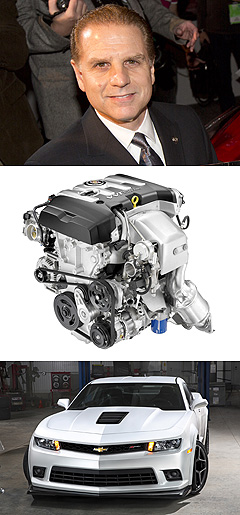GM Zeta prototype gets four-pot Opel OPC power
BY HAITHAM RAZAGUI | 9th Apr 2013

But the mysterious project does not appear to point to a future production vehicle.
Speaking exclusively with GoAuto at the recent New York motor show, GM executive chief engineer for luxury and rear-wheel-drive cars David Leone revealed the existence of a four-cylinder engineering evaluation mule based on the VE/VF Commodore’s Zeta platform.
Holden confirmed to GoAuto that one such engineering evaluation mule exists, but outside Australia – and it is not clear which Zeta-based vehicle is being used.
Using a 204kW/400Nm 2.0-litre turbo-petrol engine from the Opel Astra OPC, the prototype produces almost as much power and a healthy 50Nm more torque than the 3.6-litre V6 used in the sporty Commodore SV6.
If fitted to a Commodore, the drivetrain would outmuscle the 179kW/353Nm 2.0-litre four-cylinder turbo in the rival Ford Falcon EcoBoost.
But Mr Leone told GoAuto the first four-cylinder Commodore since the 1.9-litre VC and VH of the early 1980s is “not in the near future”, citing slow sales of the four-pot Falcon.
“I tracked the data and the four-cylinder Falcon from a sales standpoint is insignificant, it doesn’t look like it helped them (Ford),” he said.
“They (Ford) are able to claim segment-best fuel economy with it, but it does look like that’s where the claim stops because it doesn’t look like the Australian customer is migrating to that – there are more six-cylinder sales than there are four-cylinder.
“Perception lags reality in this business and it (four-cylinder Falcon) is quite a good car but it doesn’t appear to be getting the customer.”

Another factor is that the Falcon EcoBoost’s official combined fuel consumption figure of 8.1 litres of fuel per 100km is the same as the smaller, front-drive Astra OPC.
As such, it would be hard for GM’s four-cylinder engine to achieve similar figures in the heavier Commodore, or even match the the 3.0-litre V6 engine, which uses 8.9L/100km (the 3.6 uses 9.5L/100km).
Mr Leone was pleased with the results from transplanting the highly-strung – 102kW per litre – engine from an Astra to a comparatively weighty, rear-drive Zeta vehicle.
“It feels quite strong ... we have some Zetas running around with that (engine) in it and it is a pretty impressive powertrain,” he said.
“It’s got 400Nm of torque, 270+ horsepower – that moves people around quite well.” GM is widely rumoured to be readying the 2.0 turbo engine for the next-generation Chevrolet Camaro, just as Ford will use a 2.3-litre EcoBoost four-cylinder in the next Mustang.
The current fifth-generation Camaro was designed and engineered in Australia by Holden and shares Zeta underpinnings with the Commodore, so some of the development work done with the turbo engine could feed into the sixth-gen project.
However, though GM has not yet announced what platform the next Camaro will ride on, it is almost certain to use the newer Alpha platform.
Late last year GM announced production of the sixth-gen pony car will move from Oshawa in Ontario, Canada, to the Lansing Grand River plant in Michigan, alongside the Cadillac ATS and CTS that are both based on Alpha underpinnings.
Both ATS and CTS are rear-drive and already available with the potent turbo four, which first appeared under the bonnet of the Pontiac Solstice sportscar produced from 2005 until 2009, when GM shut down the Pontiac brand.